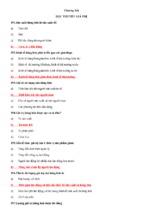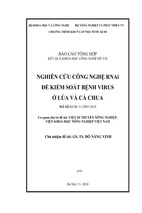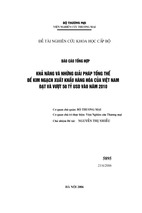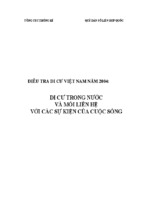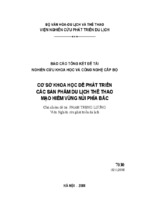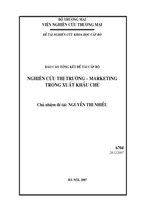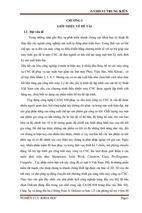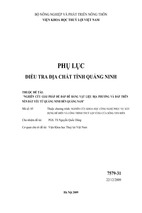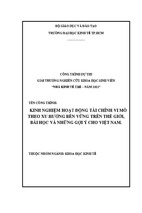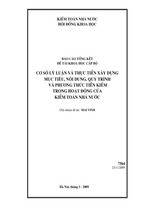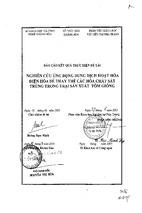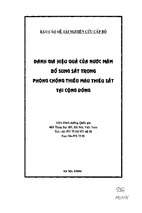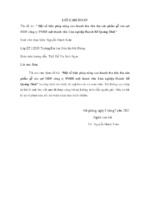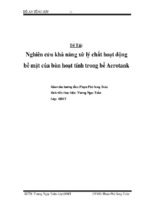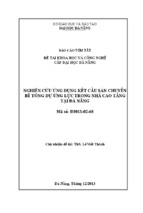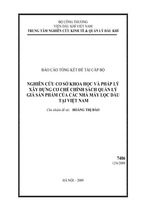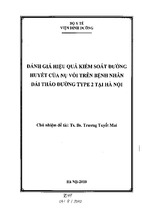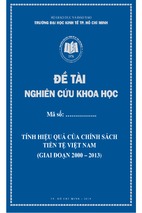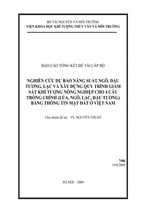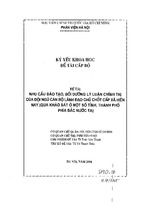VEPR Working Paper
WP-11
Production Inefficiency of Vietnam’s Fisheries Processing Firms
Scott E. Atkinson, Le Van Chon, Le Dang Trung
2011 Vietnam Centre for Economic and Policy Research
University of Economics and Business, Vietnam National University Hanoi
WP-11
Production Inefficiency of Vietnam’s Fisheries Processing Firms
Scott E. Atkinson1, Le Van Chon2, Le Dang Trung3
This paper should not be reported as representing the views of the VEPR. The views expressed
in this report are those of the author(s) and do not necessarily represent those
of the VEPR.
1
Department of Economics, University of Georgia Athens, GA 30602. Email:
[email protected]
Department of Economics, University of Georgia Athens, GA 30602. Email:
[email protected]
3
Institute of Food and Resource Economics, University of Copenhagen. Email:
[email protected]
2
Contents
Abtracts………………………………………………………………………………………..
2
1. Introduction…………………………………………………………………………………
3
2. Vietnam’s Fisheries Sector…………………………………………………………………
4
3. Shadow Cost System……………………………………………………………………….. 8
4. Econometric Estimation……………………………………..……………………………... 9
a. A Stochastic Translog Shadow Cost System……………………...………………………..
9
b. Measuring Economies of Scale……...……………………………………………………... 13
c. Measuring Allocative Inefficiency ………………………………..……………………….. 13
d. Measuring Technical Inefficiency and Productivity Change….…………………………… 14
5. Data and Empirical Results .……………………………………………………………….. 15
6. Conclusions ………………..……………………………………………………………….
20
References …………………………………………………………………………………….
22
Figures
Figure 1: Aquatic Production (thousand tons) of Vietnam, Bangladesh, Cambodia, Thailand
and Myanmar in 1990 - 2007 ……….……………………………………………………….. 25
Figure 2: Vietnam’s Capture and Aquaculture Production (thousand tons) in 19902007…………………………………………………………………………………………… 26
Figure 3: Aquaculture Area (thousand hectares) by Region in 1995 – 2007 ...……………… 27
Figure 4: Aquaculture Production (thousand tons) by Region in 1995 - 2007………………..
28
Tables
Table 1: Posterior Medians for klft (4 groups)…………………………………………………
29
Table 2: Posterior Medians for Relative Inefficiencies for Labor (4 groups)………………… 30
Table 3: Posterior Medians for klft (6 groups) ………………………………………………...
31
Table 4: Posterior Medians for Relative Inefficiencies for Labor (6 groups)………………… 32
Table 5: Posterior Medians for klft (4 groups) in a Cross-section Sample…….………………
33
Table 6: Posterior Medians for klft (6 groups) in a Cross-section Sample ……………………. 34
Table 7: Posterior Medians for Scale Economies of the 4 Groups’ Median Firms …………..
35
Table 8: Posterior Medians for Scale Economies of the 6 Groups’ Median Firms …………..
36
Table 9: Posterior Medians for TE, EC, TC, and PC (4 groups)……………………………...
37
Table 10: Posterior Medians for TE, EC, TC, and PC (6 groups)…………………………….
38
Abstract
Vietnam has experienced a dramatic growth in its fisheries sector over the last two
decades. One key factor underlying the impressive achievements of this sector is the
rapid growth of the processing firms, which include both state-owned and privatelyowned firms. In order to measure their technical and allocative efficiency, we estimate
a shadow cost system using a Bayesian Markov Chain Monte Carlo procedure. We find
that firms have not fully exploited economies of scale. They are likely to over-utilize
labor relative to capital, but those located in the Mekong delta generally perform
better than those located in other regions. Small firms tend to have higher allocative
efficiency than larger ones. Interestingly, based on this measure, while in other regions
state-owned enterprises do worse than private enterprises, the pattern seems to be
reversed in the Mekong delta. In addition, large fluctuations in efficiency change and
productivity change across several firms may indicate the vulnerability of weaker firms
to competition from international trade.
JEL codes: C1, C3, L0, O3
Keywords: Allocative Inefficiency, Gibbs Sampling, Productivity Change, Technical
Change, Technical Inefficiency
2
1
Introduction
Since the early 1990s, the fisheries1 sector has been one of the most dynamic and fastest
growing sectors in Vietnam. In 1990-2007, total production increased 4.6 times from 941
thousand tons to over 4.3 million tons. Although the sector contributes roughly 4 percent of
GDP, its value added in fish processing, distribution, and marketing is significant. The sector
has quickly surpassed other traditional Vietnamese agricultural products such as rice and
rubber in terms of export values. Its foreign exchange earnings are now the third largest,
after the crude oil and garment industries. According to Vietnam’s Ministry of Fisheries
(MOFI, 2005), the sector supplies about 40 percent of animal protein in the national human
diet and has generated approximately four million jobs.
The rapid expansion of the fisheries sector over the past few decades, however, has led to
a high risk of environmental pollution and overfishing, causing hardship for many coastal and
downriver communities. In addition, stringent requirements of export markets have raised
growing concerns about traceability and quality control of inputs, processing, and relevant
services. These issues, among others, will probably hinder the sector’s long-term sustainable
development.
Despite the important role of the fisheries sector in the Vietnamese economy, there are
few studies on this sector. Pomeroy et al. (2008) critically review changes in government
policy towards small-scaled fisheries in Vietnam, of which the subsidized-interest scheme to
expand the off-shore fleet, according to Nguyen and Symington (2008), is claimed to have
contributed to greater fishing of in-shore waters and a greater reduction of in-shore resources.
Lem et al. (2004) evaluate measures to improve domestic marketing arrangements to satisfy
the increasing local consumption of fish stimulated by strong economic growth. Following the
anti-dumping case brought against the Vietnamese catfish industry by the Catfish Farmers
of America (CFA), Nguyen (2003) examines intensively the low production cost of catfish in
the Mekong delta. But there are no studies so far on the production efficiency of fisheries
1
In this paper, fisheries include capture/fishing and aquaculture.
3
processing firms in Vietnam.
This paper investigates whether these firms have attained allocative and technical efficiency. To that end, a shadow cost system is estimated with the data from the 2003 and
2005 Enterprise Censuses surveyed by Vietnam’s General Statistics Office (GSO). Since the
data are limited, we employ a Bayesian Markov Chain Monte Carlo (MCMC) parametric
approach developed by Atkinson and Dorfman (2005). We find that firms have not fully
exploited economies of scale. Nearly all of the firms over-utilize labor relative to capital,
but those located in the Mekong delta generally perform better than those located in other
regions. Small firms, having less than 300 employees, tend to have higher allocative efficiency than larger ones. Interestingly, while in other regions state-owned enterprises (SOEs)
do worse than private enterprises in this measure, the pattern seems to be reversed in the
Mekong delta. In addition, large fluctuations in efficiency change and productivity change
across several firms may indicate the vulnerability of weaker firms to competition from international trade.
The paper is structured as follows. In section 2, we give a brief overview of Vietnam’s
fisheries sector’s performance in recent years. Section 3 reviews the shadow cost system.
In section 4, we present the econometric model. Section 5 discusses the empirical results.
Conclusions follow in section 6.
2
Vietnam’s Fisheries Sector
Fishing and aquaculture are ancient traditions in Vietnam. But it was not until the late
1980s, when the comprehensive economic reform was introduced, that the fisheries sector
started growing remarkably. Vietnam has outperformed other neighboring countries in terms
of production. Its annual growth rate from 1990 to 2007 is on average 9.37 percent, higher
than that of Bangladesh, Thailand, and Myanmar. (The exception is Cambodia, which had
a rather low base). Figure 1 shows that, while in 1990 Vietnam, Bangladesh, and Myanmar
4
had approximately the same output levels, in 2007 Vietnam left Bangladesh and Myanmar
far behind and even overtook Thailand, whose aquatic production was three times greater
than that of Vietnam in 1990.
Export earnings from shrimp, fish and other seafood products increased by 7.26 times
between 1995 and 2008, reaching $4.5 billion and making this sector the third most prominent
after the crude oil and garment industries. In the same period, the export volume of rice,
which once symbolized Vietnam’s success in its early stages of reform, rose by only 2.4 times.
Aquatic products are now exported to over 100 countries and territories. The major markets
are the U.S., Japan, China, Korea, Taiwan, and the EU.
The outstanding performance of the fisheries sector is attributed to the abundance of
aquatic resources. Vietnam has a coastline of about 3,600 km, with many bays and estuaries,
mangrove forests2 of more than 1,500 km2 , and an exclusive economic zone3 of over one
million km2 (MOFI, 2005). In addition, the inland area is netted with a dense river network,
including 2,360 rivers of more than 10 km in length. It is estimated that the total water
surface potentially available for freshwater capture or aquaculture is 17,000 km2 . The great
diversity of resources generates considerable opportunities for the development of not only
the fisheries sector, but other industries such as tourism and transportation.
Since the majority of fishing vessels are equipped with engines of less than 90 horsepower
(hp), capture activities are mostly small-scaled and concentrated in coastal waters. The
increase in human population has resulted in heavy pressure on in-shore resources. According
to MOFI (2005), catch per unit of effort decreased from 0.7 tons/hp/year in 1993 to 0.4
tons/hp/year in 2003, implying a rapid decline in productivity. In response, the government
has strongly promoted off-shore capture since 1997 through a subsidized-interest scheme
that has financed construction of 1,300 off-shore vessels4 . However, due to the lack of off2
Mangroves are crucial to the sustainability of Vietnam’s fisheries since they provide habitat for coastal
and marine fish and crustacea.
3
An exclusive economic zone is the sea zone within which a coastal state has sovereign rights for exploration and exploitation of marine resources. This area extends seaward 200 nautical miles from the
coast.
4
Vessels are classified as off-shore if their engines are over 90 hp.
5
shore technology, the inexperience by skippers and crew, meager supporting services, and
inappropriate specifications of vessels, the subsidized vessels have suffered a high failure
rate. In 2003, roughly 90% of them could not meet their repayment schedules, although the
interest rate was reduced from 7% to 5.4% (MOFI and World Bank, 2005). Moreover, some
of these large vessels fish in-shore, causing faster depletion of coastal resources. As a result,
the capture-production in Vietnam increased by only 2.7 times in 1990-2007 (see Figure 2).
The driving force underlying the impressive achievements of the fisheries sector is aquaculture. Its output has grown on average at 16.6% annually since 1990, from 162,076 tons
to 2,194,500 tons, contributing more than 50% by weight to total fishery production (FAO).
Dramatic expansion over the last two decades is the result of a sharp increase in aquaculture
exports. Aquaculture farmers have adapted shrimp and catfish species suitable for export.
Cultural practices have been diversified, including mono- and poly-aquaculture in fresh,
brackish, and marine waters as well as integrated aquaculture with paddy rice production.
The total aquaculture area has enlarged significantly to 1,019 thousand hectares (ha)5
by 2007, averaging 7% annual growth since 1995. Figures 3 and 4 indicate that aquaculture
is expanding in all regions, but the Mekong delta dominates in terms of both area and
production, representing 71% and 72%, respectively, of Vietnamese totals. With capture
taken into account, the Mekong delta is the largest contributor, with two-thirds of Vietnam’s
fisheries production (GSO, 2009).
Another key factor that has helped boost the fisheries sector is the development of processing firms. This sub-sector has expanded rapidly, particularly with the construction of
large modern facilities. In 2003, Vietnam had about 400 registered processing plants with
approximately 0.8 million tons of input capacity (Ruckes and Nguyen, 2004). Around half
of them were located in the Mekong delta. Seventy four percent of processors had Hazard
Analysis at Critical Control Points (HACCP) certification and 100 enterprises were certified
for the EU market. By 2006, the number of plants having EU certification increased to
5
A hectare is equal to 10,000 m2 , and equivalent to 2.471 acres.
6
209. In addition, 300 plants were eligible to export their products to the U.S. (Ta, 2006).
According to the MOFI and World Bank (2005), processors employ an average of nearly 300
people, of whom 80-85% are female. These jobs are valuable to poor communities (e.g., the
Khmer community in Soc Trang province). Often workers are exposed to several potential
long-term health risks, although improvements are being made.
Apart from these companies, there are many thousands of small enterprises processing
fish products for domestic markets, with a total input capacity of roughly 330,000 tons/year
(MOFI, 2004). Their outputs include dried products, fishmeal, fish sauce, as well as frozen
and chilled products. Dried products such as dried fish, shrimp, squid, and seaweed are
popular with small businesses since the production method is simple and does not require
complicated facilities and technology.
Capture and aquaculture generally provide a wide diversity of livelihood activities and
have helped to reduce poverty among rural households. However, there are many concerns
over sustainable development. Although Vietnam has upgraded its internal sanitary legislation in line with international standards, food safety is still a big challenge. In major export
markets such as the U.S., the EU, and Japan, there is an increasing trend towards traceability and application of HACCP at the farm level in order to lower risks of contamination.
This demands knowledge, skills, and investment in infrastructure that poorer households
are likely to find very difficult to meet, since they usually do not have business connections
or property that can be used as collateral to allow them easier access to formal credit. In
addition, there are insufficient fishery supporting services, such as high quality seed, feed
and fingerlings supply, disease control, environmental management, wide-spread extension
of better fishing and farming practices, quality control systems, and market information.
7
3
Shadow Cost System
In this paper, we use a shadow cost system based on duality theory in which systems of
input demand equations can be derived by simple differentiation and estimated with flexible
functional forms. Firms are assumed to choose input quantities to minimize the total shadow
costs of the chosen levels of output.
𝑁
The theory below follows Atkinson and Primont (2002). Let x = (𝑥1 , ..., 𝑥𝑁 )′ ∈ 𝑅+
𝑀
denote an (𝑁 × 1) vector of 𝑁 nonnegative inputs and let y = (𝑦1 , ..., 𝑦𝑀 )′ ∈ 𝑅+
denote an
(𝑀 × 1) vector of 𝑀 nonnegative outputs. The input requirement set is given by
𝐿(y) = {x : x can produce y}.
(1)
Under the assumption of shadow cost minimization, the shadow cost function is
𝐶(y, p∗ ) = minx {p∗ x : x ∈ 𝐿(y)},
(2)
𝑁
is a (1 × 𝑁 ) vector of 𝑁 shadow input
where p∗ = (𝑝∗1 , ..., 𝑝∗𝑁 ) = (𝑘1 𝑝1 , ..., 𝑘𝑁 𝑝𝑁 ) ∈ 𝑅+
prices. p∗ is the price that makes the optimal input vector, h(y, p∗ ), equal to the actual
input vector, x. The 𝑘𝑛 parameters, 𝑛 = 1, ..., 𝑁 , measure the divergence of actual prices
from shadow prices.
Applying Shephard’s lemma, we obtain
∂𝐶(y, p∗ )
= ℎ𝑛 (y, p∗ ),
∂𝑝𝑛
where
∂𝐶(y,p∗ )
∂𝑝𝑛
𝑛 = 1, ..., 𝑁,
(3)
is the partial derivative of 𝐶(y, p) with respect to 𝑝𝑛 , evaluated at p∗ .
Let 𝑆𝑛 denote the shadow cost share of input n
𝑆𝑛 ≡
𝑝∗𝑛 𝑥𝑛
,
𝐶(y, p∗ )
𝑛 = 1, ..., 𝑁.
8
(4)
Rearranging (4), we have
𝑥𝑛 = 𝑆𝑛 𝐶(y, p∗ )(𝑝∗𝑛 )−1 ,
𝑛 = 1, ..., 𝑁.
(5)
The firm’s total actual cost is
𝐶𝐴 =
𝑁
∑
𝑝 𝑛 𝑥𝑛 .
(6)
𝑛=1
Substituting (5) into (6), the total actual cost function becomes
∗
𝐴
𝐶 = 𝐶(y, p )
𝑁
∑
(𝑘𝑛 )−1 𝑆𝑛 .
(7)
𝑛=1
Taking logarithms, we get
[
𝐴
∗
ln 𝐶 = ln 𝐶(y, p ) + ln
𝑁
∑
]
−1
(𝑘𝑛 ) 𝑆𝑛 .
(8)
𝑛=1
Given a flexible functional form approximation to the unobserved shadow cost function
𝐶(y, p∗ ), we can estimate allocative and technical inefficiency by joint estimation of equation
(8) and the N - 1 actual cost share equations (which are derived later) with error terms
appended to each equation. Let us now move to econometric estimation of this stochastic
shadow cost system.
4
Econometric Estimation
𝑎. 𝐴 𝑆𝑡𝑜𝑐ℎ𝑎𝑠𝑡𝑖𝑐 𝑇 𝑟𝑎𝑛𝑠𝑙𝑜𝑔 𝑆ℎ𝑎𝑑𝑜𝑤 𝐶𝑜𝑠𝑡 𝑆𝑦𝑠𝑡𝑒𝑚
Again, following Atkinson and Primont (2002), we use the translog cost function to
approximate the unobserved shadow cost function. Let 𝑓 denote an individual firm, 𝑓 =
9
1, ..., 𝐹 , and 𝑡 a time trend, 𝑡 = 1, ..., 𝑇 . The stochastic translog shadow cost function is
ln [𝐶(y𝑓 𝑡 , p∗ 𝑓 𝑡 , 𝑡)ℎ(𝜖𝑓 𝑡 )] = ln 𝐶(y𝑓 𝑡 , p∗ 𝑓 𝑡 , 𝑡) + ln ℎ(𝜖𝑓 𝑡 )
∑
1 ∑∑
= 𝛾0𝑓 𝑑𝑓 +
𝛾𝑚 ln 𝑦𝑚𝑓 𝑡 +
𝛾𝑚𝑤 ln 𝑦𝑚𝑓 𝑡 ln 𝑦𝑤𝑓 𝑡
2
𝑚
𝑚 𝑤
∑∑
∑
∗
+
𝛾𝑚𝑛 ln 𝑦𝑚𝑓 𝑡 ln 𝑝𝑛𝑓 𝑡 +
𝛾𝑛 ln 𝑝∗𝑛𝑓 𝑡
𝑚
+
𝑛
𝑛
1 ∑∑
2
𝑛
∑
𝛾𝑚𝑡 ln 𝑦𝑚𝑓 𝑡 𝑡
𝛾𝑛𝑙 ln 𝑝∗𝑛𝑓 𝑡 ln 𝑝∗𝑙𝑓 𝑡 +
𝑚
𝑙
+𝛾𝑡1 𝑡 + ln ℎ(𝜖𝑓 𝑡 ),
(9)
where 𝑑𝑓 is a dummy variable for firm f and
ℎ(𝜖𝑓 𝑡 ) = exp(𝑣𝑓 𝑡 + 𝑢𝑓 𝑡 ).
(10)
The composite error ln ℎ(𝜖𝑓 𝑡 ) is an additive error with a one-sided component, 𝑢𝑓 𝑡 ≥ 0, and
a statistical noise, 𝑣𝑓 𝑡 , assumed to be iid with zero mean.
The fixed effects approach is used here to relax strong distributional assumptions on both
𝑣𝑓 𝑡 and 𝑢𝑓 𝑡 , and the unlikely assumption of no correlation between 𝑢𝑓 𝑡 and the explanatory
variables that are required in the random effects approach. The 𝛾0𝑓 ’s, 𝑓 = 1, ..., 𝐹 , represent
time-invariant, firm-specific differences in technology. In addition, we include continuous
time interacted with the logs of output quantities and a first-order term in time to account
for the effect of time.
Logarithmic differentiation of the equation (9) yields parametric expressions for the
shadow cost shares (4),
𝑝∗𝑛𝑓 𝑡
𝑥𝑛𝑓 𝑡 𝑝∗𝑛𝑓 𝑡
∂ ln 𝐶(y𝑓 𝑡 , p∗ 𝑓 𝑡 , 𝑡)
∂𝐶(y𝑓 𝑡 , p∗ 𝑓 𝑡 , 𝑡)
=
=
= 𝑆𝑛𝑓 𝑡
∂ ln 𝑝∗𝑛𝑓 𝑡
∂𝑝∗𝑛𝑓 𝑡
𝐶(y𝑓 𝑡 , p∗ 𝑓 𝑡 , 𝑡)
𝐶(y𝑓 𝑡 , p∗ 𝑓 𝑡 , 𝑡)
∑
∑
= 𝛾𝑛 +
𝛾𝑛𝑙 ln 𝑝∗𝑙𝑓 𝑡 +
𝛾𝑚𝑛 ln 𝑦𝑚𝑓 𝑡 .
(11)
𝑚
𝑙
Substituting the stochastic translog shadow cost function and the shadow cost shares into
10
(8), we obtain the stochastic actual cost function
1 ∑∑
𝛾𝑚𝑤 ln 𝑦𝑚𝑓 𝑡 ln 𝑦𝑤𝑓 𝑡
2
𝑚
𝑚 𝑤
∑
∑∑
∗
𝛾𝑛 ln 𝑝∗𝑛𝑓 𝑡
+
𝛾𝑚𝑛 ln 𝑦𝑚𝑓 𝑡 ln 𝑝𝑛𝑓 𝑡 +
ln 𝐶𝑓𝐴𝑡 = 𝛾0𝑓 𝑑𝑓 +
𝑚
∑
𝛾𝑚 ln 𝑦𝑚𝑓 𝑡 +
𝑛
𝑛
∑
1 ∑∑
+
𝛾𝑛𝑙 ln 𝑝∗𝑛𝑓 𝑡 ln 𝑝∗𝑙𝑓 𝑡 +
𝛾𝑚𝑡 ln 𝑦𝑚𝑓 𝑡 𝑡 + 𝛾𝑡1 𝑡
2 𝑛 𝑙
𝑚
[ 𝑁
(
)]
∑
∑
∑
+ ln
(𝑘𝑛𝑓 𝑡 )−1 𝛾𝑛 +
𝛾𝑛𝑙 ln 𝑝∗𝑙𝑓 𝑡 +
𝛾𝑚𝑛 ln 𝑦𝑚𝑓 𝑡
𝑛=1
𝑙
𝑚
+𝑣𝑓 𝑡 + 𝑢𝑓 𝑡 .
(12)
The actual cost share of input 𝑛 is
𝐴
𝑆𝑛𝑓
𝑡 =
𝑝𝑛𝑓 𝑡 𝑥𝑛𝑓 𝑡
.
𝐶𝑓𝐴𝑡
(13)
Substituting (5) and (7) into (13) yields
(𝑘𝑛𝑓 𝑡 )−1 𝑆𝑛𝑓 𝑡
𝐴
𝑆𝑛𝑓
=
.
∑
𝑡
𝑁
−1
𝑛=1 (𝑘𝑛𝑓 𝑡 ) 𝑆𝑛𝑓 𝑡
(14)
Substituting for 𝑆𝑛𝑓 𝑡 from equation (11), we obtain
𝐴
𝑆𝑛𝑓
𝑡
∑
𝛾𝑛𝑙 ln 𝑝∗𝑙𝑓 𝑡 + 𝑚 𝛾𝑚𝑛 ln 𝑦𝑚𝑓 𝑡 )
= ∑𝑁
.
∑
∑
∗
−1
𝑛=1 (𝑘𝑛𝑓 𝑡 ) (𝛾𝑛 +
𝑙 𝛾𝑛𝑙 ln 𝑝𝑙𝑓 𝑡 +
𝑚 𝛾𝑚𝑛 ln 𝑦𝑚𝑓 𝑡 )
(𝑘𝑛𝑓 𝑡 )−1 (𝛾𝑛 +
∑
𝑙
(15)
We need to impose some restrictions before estimating the model. Symmetry requires
that
𝛾𝑚𝑤 = 𝛾𝑤𝑚 ,
𝛾𝑛𝑙 = 𝛾𝑙𝑛 ,
∀𝑚, 𝑤, 𝑚 ∕= 𝑤,
∀𝑛, 𝑙, 𝑛 ∕= 𝑙.
(16)
Since 𝐶(y, p∗ , 𝑡) is homogeneous of degree one in p∗ , the parameters in (9) have the following
11
relationships:
∑
𝛾𝑛 = 1,
𝑛
∑
𝛾𝑛𝑙 =
∑
𝑛
𝑙
∑
𝛾𝑚𝑛 = 0,
𝛾𝑛𝑙 =
∑∑
𝑛
𝛾𝑛𝑙 = 0,
𝑙
∀𝑚.
(17)
𝑛
The set of equations to be estimated is the actual cost function (12) and the N - 1
actual cost share equations (15), since one share equation must be dropped due to the linear
dependence of the error terms. We cannot estimate the absolute values of the 𝑘𝑛𝑓 𝑡 ’s because
the actual cost equation and the actual cost share equations are homogenous of degree zero
in the 𝑘𝑛𝑓 𝑡 ’s. Therefore, for one input 𝑛, we must restrict a 𝑘𝑛𝑓 𝑡 to some constant ∀𝑡. Here,
we restrict 𝑘𝑛𝑓 𝑡 for input N6 . For the remaining inputs, we specify
𝑘𝑛𝑓 𝑡 = exp(𝜅𝑛𝑓 + 𝜅𝑛 𝑡),
𝑛 = 1, ..., 𝑁 − 1,
(18)
which allows for firm-specific, time-invariant parameters 𝜅𝑛𝑓 and industry-wide time-varying
parameters 𝜅𝑛 that are shared across firms.
Due to limited data (which will be discussed in the next section), we are not able to
include the second-order terms in time in (18) and (12). Moreover, we employ the Bayesian
Markov Chain Monte Carlo approach developed by Atkinson and Dorfman (2009) to obtain
posterior densities for estimates of allocative inefficiency. We treat the covariance of the
errors and the unknown parameters of the shadow cost system as random variables. The
parameters are assumed to have a multivariate normal distribution.
In each draw, we first obtain the covariance matrix of the model’s stochastic errors (Ω) in
the form of the standard inverted Wishart conditional on parameter starting values. Then, we
get posterior estimates of three groups of parameters (the firm dummies, the 𝑘𝑛𝑓 𝑡 ’s, and the
6
The choice of the numeraire input does not affect the results.
12
other parameters) separately. In each step, we (i) estimate the shadow cost system, holding
previously estimated parameters constant, (ii) combine estimated parameters with priors
(zero mean, covariance matrix 𝐻0 7 ) to obtain posterior means and variances using Bayes’
theorem, (iii) draw from a multivariate normal distribution with these posterior means and
variances, (iv) impose monotonicity for at least 85% of all observations8 , and (v) proceed
to next step conditional on all previous draws. After three steps are done to gain posterior
estimates of the three groups of parameters, we regress the shadow cost system, holding Ω
constant, to get new estimates of the error terms for the next draw. A total of 28,000 Gibbs
draws are generated from two separate models. Each model contains 14,000 draws of which
the first 4,000 are discarded to remove dependence on initial starting values.
𝑏. 𝑀 𝑒𝑎𝑠𝑢𝑟𝑖𝑛𝑔 𝐸𝑐𝑜𝑛𝑜𝑚𝑖𝑒𝑠 𝑜𝑓 𝑆𝑐𝑎𝑙𝑒
According to Hanoch (1975), scale economies should be measured by the relationship
between total cost and output along the expansion path. Scale economies (SE) equal one
minus the elasticity of total cost with respect to output
∂ ln 𝐶𝑓𝐴𝑡
∂ ln 𝑦𝑚𝑓 𝑡
∑
∑
𝛾𝑚𝑛 ln 𝑝∗𝑛𝑓 𝑡 − 𝛾𝑚𝑡 𝑡
𝛾𝑚𝑤 ln 𝑦𝑤𝑓 𝑡 −
= 1 − 𝛾𝑚 −
𝑆𝐸𝑓 𝑡 = 1 −
𝑛
𝑤
∑𝑁
−1
𝑛=1 (𝑘𝑛𝑓 𝑡 ) 𝛾𝑚𝑛
).
(
∑
∑
∗
−1 𝛾 +
𝑛
𝑚 𝛾𝑚𝑛 ln 𝑦𝑚𝑓 𝑡
𝑙 𝛾𝑛𝑙 ln 𝑝𝑙𝑓 𝑡 +
𝑛=1 (𝑘𝑛𝑓 𝑡 )
− ∑𝑁
(19)
Positive scale economies receive positive numbers and scale diseconomies negative numbers.
𝑐. 𝑀 𝑒𝑎𝑠𝑢𝑟𝑖𝑛𝑔 𝐴𝑙𝑙𝑜𝑐𝑎𝑡𝑖𝑣𝑒 𝐼𝑛𝑒𝑓 𝑓 𝑖𝑐𝑖𝑒𝑛𝑐𝑦
The N - 1 relative values of 𝑘𝑛𝑓 𝑡 estimated above indicate relative price inefficiencies.
Relative price efficiency is achieved at time t if marginal rates of technical substitution equal
the corresponding ratios of market input prices or 𝑘𝑛𝑓 𝑡 = 1, 𝑛 = 1, ..., 𝑁 − 1. We then
compute ratios of fitted demands using the estimated values of 𝑘𝑛𝑓 𝑡 to efficient demands
7
𝐻0 is a diagonal matrix with diagonal elements set to 100 for the firm dummies, 0.01 for the allocative
parameters, and 100 for the other parameters.
8
The costs are monotonically increasing in input prices and outputs.
13
with 𝑘𝑛𝑓 𝑡 set equal to 1, 𝑛 = 1, ..., 𝑁 − 1. These ratios imply relative inefficiencies for input
usage.
𝑑. 𝑀 𝑒𝑎𝑠𝑢𝑟𝑖𝑛𝑔 𝑇 𝑒𝑐ℎ𝑛𝑖𝑐𝑎𝑙 𝐼𝑛𝑒𝑓 𝑓 𝑖𝑐𝑖𝑒𝑛𝑐𝑦 𝑎𝑛𝑑 𝑃 𝑟𝑜𝑑𝑢𝑐𝑡𝑖𝑣𝑖𝑡𝑦 𝐶ℎ𝑎𝑛𝑔𝑒
To compute technical efficiency (TE), efficiency change (EC), technical change (TC), and
productivity change (PC), we follow Atkinson, Cornwell, and Honerkamp (2003). For a given
level of outputs, the technically efficient firm is the one that employs the fewest inputs. We
measure EC as the rate of catching up to the frontier from period to period and TC as the
movement outward of the frontier over time. Then PC is the sum of EC and TC.
We first calculate the residuals from (12) as 𝑣ˆ𝑓 𝑡 + 𝑢ˆ𝑓 𝑡 . Since 𝑢𝑓 𝑡 needs to be non-negative,
we transform 𝑢ˆ𝑓 𝑡 by subtracting 𝑢ˆ𝑡 = 𝑚𝑖𝑛𝑓 (ˆ
𝑢𝑓 𝑡 ), which is the estimated frontier intercept
and obtain 𝑢ˆ𝐹𝑓𝑡 = 𝑢ˆ𝑓 𝑡 − 𝑢ˆ𝑡 ≥ 0. Adding and subtracting 𝑢ˆ𝑡 from the estimated (9) yields
ˆ 𝑓 𝑡 , p∗ 𝑓 𝑡 , 𝑡)ℎ(ˆ𝜖𝑓 𝑡 )] = ln 𝐶(y
ˆ 𝑓 𝑡 , p∗ 𝑓 𝑡 , 𝑡) + 𝑣ˆ𝑓 𝑡 + 𝑢ˆ𝑓 𝑡 + 𝑢ˆ𝑡 − 𝑢ˆ𝑡
ln [𝐶(y
ˆ 𝑓 𝑡 , p∗ 𝑓 𝑡 , 𝑡) + 𝑢ˆ𝑡 + 𝑣ˆ𝑓 𝑡 + 𝑢ˆ𝐹𝑓𝑡
= ln 𝐶(y
= ln 𝐶ˆ 𝐹 (y𝑓 𝑡 , p∗ 𝑓 𝑡 , 𝑡) + 𝑣ˆ𝑓 𝑡 + 𝑢ˆ𝐹𝑓𝑡 ,
(20)
ˆ 𝑓 𝑡 , p∗ 𝑓 𝑡 , 𝑡) + 𝑢ˆ𝑡 is the fitted frontier shadow cost function.
where ln 𝐶ˆ 𝐹 (y𝑓 𝑡 , p∗ 𝑓 𝑡 , 𝑡) = ln 𝐶(y
Firm 𝑓 ’s level of 𝑇 𝐸 in period 𝑡 is defined as
𝑇 𝐸𝑓 𝑡 = exp(−ˆ
𝑢𝐹𝑓𝑡 ).
(21)
TE should lie between 0 and 1 due to the normalization of 𝑢ˆ𝐹𝑓𝑡 . 𝐸𝐶𝑓 𝑡 is the change in 𝑇 𝐸𝑓 𝑡
from 𝑡 to 𝑡 + 1
𝐸𝐶𝑓 𝑡 = 𝑇 𝐸𝑓,𝑡+1 − 𝑇 𝐸𝑓,𝑡 .
(22)
𝑇 𝐶𝑓 𝑡 is estimated as the difference between ln 𝐶ˆ 𝐹 (y, p∗ , 𝑡 + 1) and ln 𝐶ˆ 𝐹 (y, p∗ , 𝑡), holding
14
input and output quantities constant,
ˆ p∗ , 𝑡 + 1) + 𝑢ˆ𝑡+1 − ln 𝐶(y,
ˆ p∗ , 𝑡) − 𝑢ˆ𝑡
𝑇 𝐶𝑓 𝑡 = ln 𝐶(y,
∑
=
𝛾ˆ𝑚𝑡 ln 𝑦𝑚𝑓 𝑡 + 𝛾ˆ𝑡1 + 𝑢ˆ𝑡+1 − 𝑢ˆ𝑡 .
(23)
𝑚
Given 𝐸𝐶𝑓 𝑡 and 𝑇 𝐶𝑓 𝑡 , we obtain 𝑃 𝐶𝑓 𝑡 :
𝑃 𝐶𝑓 𝑡 = 𝑇 𝐶𝑓 𝑡 + 𝐸𝐶𝑓 𝑡 .
5
(24)
Data and Empirical Results
The data used in this paper are from the Enterprise Censuses surveyed by Vietnam’s
General Statistics Office. These surveys have been conducted annually since 2000. They
are designed to collect systematically information on quantities of factors of production and
the performance of firms that came into operation by January 1𝑠𝑡 of that year and were still
in business. The survey data can be used to evaluate competitiveness in all industries and
sectors of the Vietnamese economy.
Those enterprises under survey are either state-owned, ‘equitized’9 , domestically private,
joint ventures, or 100% foreign-owned and are doing business in farming, aquaculture, mining, processing, electricity, gas and water, construction, trading, manufacturing, hospitality,
transportation, finance, health, education, among others. The questionnaires cover revenue,
taxes, number of employees and their income, assets, liabilities and equity, investments, onthe-job training, and input costs including fuel, raw materials, services and utilities, etc.
The GSO follows a stratified random cluster sampling procedure so that the sample’s results
are statistically representative of industries and sectors at the national and regional levels.
A cost section is included in questionnaires only in odd-numbered years. Data with costs
9
SOEs in Vietnam have undergone a reform in which their equity shares continue to be kept by the State
or are sold fully or partly to the private sector. ‘Equitized’ firms are those owned partly by the State and
partly by the private sector.
15
information included are available for 2001, 2003, and 200510 . But a very large percentage of
firms did not fully report their costs, especially for 2001 and 2003. Those firms whose data
are missing are more likely to be smaller and private. Therefore, inferences should be made
with caution. The data situation is better for 2005, though far from perfect. For this year,
there are 685 enterprises in the fisheries processing sector, but only 223 firms report revenue
and cost data. We have to drop 41 firms, among which 1 firm has negative revenue, 13
have negative equities, 1 has negative liabilities, 2 have zero total costs, 8 have non-positive
capital, 10 have negative values added, 3 have extraordinarily high wages, 2 have negative
corporate tax rates, and 1 has an interest rate greater than 100%. That leaves 182 firms.
Merging them with the 102 firms from 2003 produces a balanced panel with only 47 firms.
We employ this panel that has 94 observations.
In this study, the fisheries processing firms’ output or value added is a function of two
inputs: capital (K) and labor (L). The price of labor, 𝑝𝑙 , is the wage rate, defined as the sum
of salaries, wages and other benefits, divided by the average number of employees. The price
of capital, 𝑝𝑘 , is calculated by the Christensen-Jorgenson (1969) rental price index defined
as
𝑝𝑘 = (𝑟 + 𝛿)
1 − 𝑏𝑑𝑠
,
1 − 𝑏𝑠
(25)
where
𝑟 = interest rate,
𝛿 = rate of depreciation,
𝑏 = corporate income tax rate,
𝑑 = present value of depreciation allowances, and
𝑠 = ratio of equity to total capitalization.
Straight-line depreciation is assumed. Because enterprises are likely to depreciate their as10
The survey questionnaire in 2007 does not include a cost section as expected.
16
sets as fast as possible to reduce their tax burden, Vietnam’s Ministry of Finance issued
decree No. 206, which states that the minimum number of years for assets in the food processing industries to be completely depreciated is 7 years. The present value of depreciation
allowances is
[
(
)7 ]
1
1
𝑑=
1−
.
7𝑟
1+𝑟
Since the number of time periods T is just two (i.e., years 2003 and 2005), it is not
possible to include the second-order terms in time in (12) and (18) and to estimate separate
values of 𝑘𝑛𝑓 𝑡 for individual firms. One possibility for identifying the 𝑘𝑛𝑓 𝑡 ’s is to divide the
sample into groups of firms. The 47 firms are grouped in two ways: (a) 4 groups based on
location (in vs. out of the Mekong delta) and firm size (small vs. large), and (b) 6 groups
based on location and firm ownership (state-owned, equitized vs. private). The shadow cost
system is thus run twice accordingly.
The shadow cost system is comprised of the total actual cost function (12) and one actual
cost share equation (15) and estimated with the restrictions (16) and (17) imposed. Because
we cannot estimate two absolute values 𝑘𝑙𝑓 𝑡 and 𝑘𝑘𝑓 𝑡 , we normalize 𝑘𝑘𝑓 𝑡 = 1, for 𝑡 = 1, 2,
and 𝑓 = 1, ..., 47. The condition for relative price efficiency then becomes 𝑘𝑙𝑓 𝑡 = 1. Table
1 presents posterior medians for estimates of 4 groups’ 𝑘𝑙𝑓 𝑡 ’s in 2003 and 2005. All of them
are less than 1, meaning that the ratio of the shadow price of labor to that of capital is
lower than the corresponding ratio of actual prices. This implies widespread over-utilization
of labor relative to capital, which is supported by the fact that ratios of fitted to efficient
demands for labor are all greater than 1 (see Table 2).
Moreover, firms located in the Mekong delta have higher values of 𝑘𝑙𝑓 𝑡 than those located
in other regions in both years. This is probably attributable to more intense competition in
the nation’s biggest marine food producing basin. Small enterprises also have bigger 𝑘𝑙𝑓 𝑡 ’s
than larger ones. Due to the availability of a large pool of low cost labor in Vietnam that
17
firms seem to have easier access to than to capital, they are likely to use much more labor as
their production expands. This fact is strengthened when we compare years 2003 and 2005.
Generally, four groups of firms grew in size from 2003 to 2005, and their 𝑘𝑙𝑓 𝑡 ’s all decline
over time.
Relative over-utilization of labor is revealed clearly in Table 2. All groups employ labor
more than they should. The patterns displayed here correspond to those indicated in Table
1. Allocative inefficiencies are worse for out-of-Mekong enterprises in the two time periods.
Small firms have more efficient input combinations than larger ones in other regions of the
country, but this does not hold for firms in the Mekong delta. Large firms’ weighted-average
ratios of fitted to efficient demands for labor (where the weights are firms’ shares of their
group’s total output) are smaller, suggesting that several bigger companies in this group
may actually use labor more properly than the small-firm group.
Tables 3 and 4 give posterior medians for estimates of 𝑘𝑙𝑓 𝑡 ’s and relative inefficiencies for
6 groups, which are categorized based on location and ownership. The range of their values
is similar to that in Tables 1 and 2. Firms in the Mekong delta are more allocatively efficient
than those located elsewhere, except for private firms. While private firms in other regions
have the highest values of 𝑘𝑙𝑓 𝑡 for both years, their counterparts in the Mekong delta have
the lowest.
This may be caused by two reasons. First, the composition of the private firm group may
not be well representative for the Mekong delta where small private firms tend to be less
transparent financially and, hence, are dropped from the sample. For the 17 private firms
in the sample that are based in the Delta, more than half (9) are classified as large. It is
more acceptable for 13 private firms located elsewhere when 5 of them are large. Second,
the State has actively chosen to keep large and well-performing SOEs and gradually sold the
unsound ones. Although the retained SOEs may or may not sustain their competitiveness
in the long term, they are likely to perform better than private firms, at least in the short
term.
18


